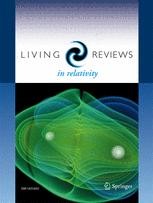Living Reviews in Relativity: "Testing the nature of dark compact objects"
 Cardoso, V. & Pani, P., "Testing the nature of dark compact objects: a status report", Living Rev Relativ (2019) 22: 4. https://doi.org/10.1007/s41114-019-0020-4
Cardoso, V. & Pani, P., "Testing the nature of dark compact objects: a status report", Living Rev Relativ (2019) 22: 4. https://doi.org/10.1007/s41114-019-0020-4
Open Access | Review Article
First Online: 08 July 2019
Abstract:
Very compact objects probe extreme gravitational fields and may be the key to understand outstanding puzzles in fundamental physics. These include the nature of dark matter, the fate of spacetime singularities, or the loss of unitarity in Hawking evaporation. The standard astrophysical description of collapsing objects tells us that massive, dark and compact objects are black holes. Any observation suggesting otherwise would be an indication of beyond-the-standard-model physics. Null results strengthen and quantify the Kerr black hole paradigm. The advent of gravitational-wave astronomy and precise measurements with very long baseline interferometry allow one to finally probe into such foundational issues. We overview the physics of exotic dark compact objects and their observational status, including the observational evidence for black holes with current and future experiments.
The Author:
Vitor Cardoso is Professor of Physics at the Instituto Superior Técnico, Lisbon; a CERN Scientific Associate; and Adjunct Professor of Physics at the University of Mississippi. He is chair of the European COST Action CA16104 program on "Gravitational Waves, Black Holes and Fundamental Physics". His research interests include black hole physics, gravitational-wave physics and General Relativity.
Paolo Pani is an Associate Professor of Theoretical Physics at Sapienza University of Rome. He is the PI of the ERC DarkGRA project. His research interests include black holes, foundations of General Relativity and relativistic astrophysics.
Vitor Cardoso and Paolo Pani are also co-authors (with Richard Brito) of the book "Superradiance: Energy Extraction, Black-Hole Bombs and Implications for Astrophysics and Particle Physics" (Springer 2015).
